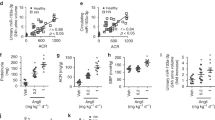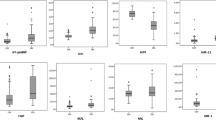Abstract
Recently, miRNAs have emerged as new indirect markers of inflammation that are associated with adverse outcomes in cardiovascular disease. The aim of the study was to evaluate the relationship between miR29a and proteinuria in hypertension. Fifty patients with normal albuminuria, fifty patients with micro-albuminuria, and fifty patients with macro-albuminuria were enrolled. The highest levels of miR-29a and transforming growth factor-β1 (TGF-β1) were observed in the macro-albuminuria group, followed by the micro-albuminuria and the normal albuminuria groups. The level of miR-29a was negatively correlated with the glomerular filtration rate, but was positively correlated with C-reactive protein, TGF-β1, and the urinary albumin to creatinine ratio (UACR). Circulating miR-29a was found to be significantly and independently associated with proteinuria. Our findings showed that miR-29a reflects the pathogenesis of hypertensive nephropathy and may serve as a potential non-invasive marker for detecting early stages of hypertensive nephropathy.
This is a preview of subscription content, access via your institution
Access options
Subscribe to this journal
Receive 12 digital issues and online access to articles
$119.00 per year
only $9.92 per issue
Buy this article
- Purchase on Springer Link
- Instant access to full article PDF
Prices may be subject to local taxes which are calculated during checkout


Similar content being viewed by others
References
Levey AS, Coresh J. Chronic kidney disease. Lancet. 2012;379:165–80.
Seccia TM, Caroccia B, Calo LA. Hypertensive nephropathy. Moving from classic to emerging pathogenetic mechanisms. J Hypertens. 2017;35:205–12.
Mancia G, Laurent S, Agabiti-Rosei E, Ambrosioni E, Burnier M, Caulfield MJ, et al. Reappraisal of European guidelines on hypertension management: a European Society of Hypertension Task Force document. J Hypertens. 2009;27:2121–58.
Redon J, Martinez F. Microalbuminuria as surrogate endpoint in therapeutic trials. Curr Hypertens Rep. 2012;14:345–9.
Wei Q, Mi QS, Dong Z. The regulation and function of microRNAs in kidney diseases. IUBMB Life. 2013;65:602–14.
Tian D, Ling S, Chen G, Li Y, Liu J, Ferid M, et al. Hypertensive nephropathy treatment by heart-protecting musk pill: a study of anti-inflammatory therapy for target organ damage of hypertension. Int J Gen Med. 2011;4:131–9.
Jones TF, Bekele S, O’Dwyer MJ, Prowle JR. MicroRNAs in acute kidney injury. Nephron 2018;139:1–5.
Synetos A, Toutouzas K, Stathogiannis K, Latsios G, Tsiamis E, Tousoulis D, et al. MicroRNAs in arterial hypertension. Curr Top Med Chem. 2013;13:1527–32.
Ooi JY, Bernardo BC, McMullen JR. The therapeutic potential of miRNAs regulated in settings of physiological cardiac hypertrophy. Future Med Chem. 2014;6:205–22.
Parthenakis FI, Marketou ME, Kontaraki JE, Maragoudakis F, Maragkoudakis S, Nakou H, et al. Comparative microRNA profiling in relation to urinary albumin excretion in newly diagnosed hypertensive patients. J Hum Hypertens. 2016;30:685–9.
Kriegel AJ, Liu Y, Fang Y, Ding X, Liang M. The miR-29 family: genomics, cell biology, and relevance to renal and cardiovascular injury. Physiol Genom. 2012;44:237–44.
Castoldi G, di Gioia C, Giollo F, Carletti R, Bombardi C, Antoniotti M, et al. Different regulation of miR-29a-3p in glomeruli and tubules in an experimental model of angiotensin II-dependent hypertension: potential role in renal fibrosis. Clin Exp Pharmacol Physiol. 2016;43:335–42.
Pezzolesi MG, Satake E, McDonnell KP, Major M, Smiles AM, Krolewski AS. Circulating TGF-beta1-regulated miRNAs and the risk of rapid progression to ESRD in type 1 diabetes. Diabetes. 2015;64:3285–93.
Tang PM, Zhang YY, Mak TS, Tang PC, Huang XR, Lan HY. TGF-beta signalling in renal fibrosis: from Smads to non-coding RNAs. J Physiol 2018;596:3493–503.
Castro NE, Kato M, Park JT, Natarajan R. Transforming growth factorbeta1 (TGF-beta1) enhances expression of profibrotic genes through a novel signaling cascade and microRNAs in renal mesangial cells. J Biol Chem. 2014;289:29001–13.
Wang B, Komers R, Carew R, Winbanks CE, Xu B, Herman-Edelstein M, et al. Suppression of microRNA-29 expression by TGF-beta1 promotes collagen expression and renal fibrosis. J Am Soc Nephrol. 2012;23:252–65.
Lan HY. Diverse roles of TGF-beta/Smads in renal fibrosis and inflammation. Int J Biol Sci. 2011;7:1056–67.
Liu LS. [2010 Chinese guidelines for the management of hypertension]. Zhonghua Xin Xue Guan Bing Za Zhi. 2011;39:579–615.
Mitchell PS, Parkin RK, Kroh EM, Fritz BR, Wyman SK, Pogosova-Agadjanyan EL, et al. Circulating microRNAs as stable blood-based markers for cancer detection. Proc Natl Acad Sci USA. 2008;105:10513–8.
Huang Y, Chen J, Zhou Y, Tang S, Li J, Yu X, et al. Circulating miR155 expression level is positive with blood pressure parameters: Potential markers of target-organ damage. Clin Exp Hypertens. 2016;38:331–6.
Kang K, Zhang X, Liu H, Wang Z, Zhong J, Huang Z, et al. A novel real-time PCR assay of microRNAs using S-Poly(T), a specific oligo(dT) reverse transcription primer with excellent sensitivity and specificity. PLoS One. 2012;7:e48536.
Baraniskin A, Nopel-Dunnebacke S, Ahrens M, Jensen SG, Zollner H, Maghnouj A, et al. Circulating U2 small nuclear RNA fragments as a novel diagnostic biomarker for pancreatic and colorectal adenocarcinoma. Int J Cancer. 2013;132:E48–57.
Association AD. Standards of medical care in diabetes--2013. Diabetes Care. 2013;36(Suppl 1):S11–S66.
Mihajlov R, Stoeva D, Pencheva B, Bogusheva E, Ruseva A, Gencheva-Angelova I. Albuminuria and glomerular filtration in patients with essential hypertension. Clin Lab. 2015;61:677–85.
Kopp JB. Rethinking hypertensive kidney disease: arterionephrosclerosis as a genetic, metabolic, and inflammatory disorder. Curr Opin Nephrol Hypertens. 2013;22:266–72.
Yamamoto T, Noble NA, Miller DE, Border WA. Sustained expression of TGF-beta 1 underlies development of progressive kidney fibrosis. Kidney Int. 1994;45:916–27.
Ding Y, Choi ME. Regulation of autophagy by TGF-beta: emerging role in kidney fibrosis. Semin Nephrol. 2014;34:62–71.
Mennuni S, Rubattu S, Pierelli G, Tocci G, Fofi C, Volpe M. Hypertension and kidneys: unraveling complex molecular mechanisms underlying hypertensive renal damage. J Hum Hypertens. 2014;28:74–9.
Mehta T, Buzkova P, Kizer JR, Djousse L, Chonchol M, Mukamal KJ, et al. . Higher plasma transforming growth factor (TGF)-beta is associated with kidney disease in older community dwelling adults. BMC Nephrol. 2017;18:98.
Zhu S, Liu Y, Wang L, Meng QH. Transforming growth factor-beta1 is associated with kidney damage in patients with essential hypertension: renoprotective effect of ACE inhibitor and/or angiotensin II receptor blocker. Nephrol Dial Transplant. 2008;23:2841–6.
Ramdas V, McBride M, Denby L, Baker AH. Canonical transforming growth factor-beta signaling regulates disintegrin metalloprotease expression in experimental renal fibrosis via miR-29. Am J Pathol. 2013;183:1885–96.
Lan HY, Chung AC. Transforming growth factor-beta and Smads. Contrib Nephrol. 2011;170:75–82.
Acknowledgements
We thank all the participating volunteers for their efforts and contributions. This work was supported by the Natural Science Foundation of Guangdong Province (No. 2015A030313660), the Science and Technology Program of Guangzhou (No.201604020143, No.201604020018, No.201510010254, No.201803030012), the Medical Science and Technology Research Fund of Guangdong Province (No.B2018023), the National Key Research and Development Program of China (No.2017FYC1307603) and the Science and Technology Program of Guangdong Province (No.2014B020212008).
Author information
Authors and Affiliations
Corresponding authors
Ethics declarations
Conflict of interest
The authors declare that they have no conflict of interest.
Rights and permissions
About this article
Cite this article
Huang, Yq., Huang, C., Li, J. et al. The association of miR-29a with proteinuria in essential hypertension. J Hum Hypertens 32, 775–780 (2018). https://doi.org/10.1038/s41371-018-0097-3
Received:
Revised:
Accepted:
Published:
Issue Date:
DOI: https://doi.org/10.1038/s41371-018-0097-3
This article is cited by
-
Impact of Nutritional Epigenetics in Essential Hypertension: Targeting microRNAs in the Gut-Liver Axis
Current Hypertension Reports (2021)



